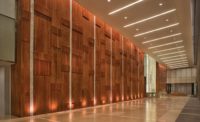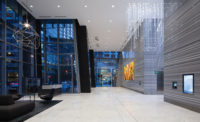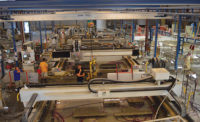“My inspiration for the lobby was simply the notion of time,” explained Randal. “Amongst the seemingly infinite number of both inorganic and organic ‘things’ on this planet, only the human being can be affected psychologically by the idea of time passing. Of course, everything on this planet, including those entities we consider permanent, such as the mountains, oceans and atmosphere, physically change over time. However, it is only the human who can be consciously affected by the concept of time and consequently react to the present and plan for the future.
“The lobby’s brown, white and gray palette, including the dual-toned aqua and cobalt blue sofa, reflects the basic molecular foundation of Mother Earth herself, while the repetitive pattern formalized by the textured stone walls represents what is ostensibly immutable and ‘forever,’” Haworth went on to say. “In contradistinction to this is the massive 18-foot-long marble reception counter, which is transformed from violent, yet beautiful chaos, into a traditionally refined smooth surface. As a metaphor of how modern plastic surgery can make unappealing forms into beautiful ones, the sculptural transformation reminds us we can change how we appear over time.”
The doctor explained how he has always been attracted to all types of stone construction since he was a child attending the King’s School in Canterbury, England, which he said is purportedly the oldest school in the world. “Many of the classrooms and dorms were based within ancient Gothic stone buildings surrounding the 1,400-year-old Canterbury Cathedral, so for me, stone represented stability, strength and wisdom. Stone is far more than just a construction material — within its austerity lies timeless beauty,” he said.
The lobby walls consist of an alternating formation of both protruding and recessed multi-tiled pieces — totaling 120 square feet. “I had each tile section individually assembled from a rare and now unavailable source of distressed unfinished 2- x 8-inch marble tile veneer that came in old wood crates from Italy,” said Haworth. “The combination of the particular marble’s texture — along with the pattern and manner in which it was assembled — was chosen to maximize depth.”
The showpiece of the 240-square-foot office lobby is the mammoth reception desk made from two massive slabs of Carrara marble. These were divided into nine pieces in order to complement the full 18-foot length of the counter.
“The stone materials were chosen from both an aesthetic and practical standpoint,” explained Randal. “I was looking for a white purity for the wall themselves, while the slabs for the reception counter were chosen for a certain multi-variegated pattern, as well as thickness. The thickness was needed to accommodate both violent carving and impart mass in the end.”
The stone was supplied by Empire Marble in San Fernando Valley, CA.
The installation
When it came to the stone installation, Randal was intimately involved with the 1-ton reception counter. “Indeed, I rolled up my sleeves to carve and polish the structure and ultimately camouflage its seams because, it turned out, I was the only one who knew what I envisioned,” he explained. “I experimented with a number of painterly techniques in order to visually unify the individual sections of marble as one horizontal massive rock. For the foundation, a pony wall was set up as the main anchoring frame spanning from the left corner adjoining the tiled wall to the right suspended handicap accessible section.
Creating and anchoring the reception desk was a trial-and-error process, explained Haworth. “As experienced and proficient as they were in their craft, I realized my team was inadequately prepared for what I wanted to create,” he said. “It was basically my fault because my inexperience did not allow me to realize theirs in handling this one idiosyncratic aspect of the total project. It was as much about structural engineering as it was about art. I realized that when you are utilizing others to translate your vision of something that is unique and out of their comfort zone, you must seek top specialists in that particular medium you want to work with. For example, despite the innumerable conversations and detailed drawings I provided to the architect, project manager, engineer and marble craftsman, the form of the counter during construction began to differ widely from what I was envisioning. It was fortunate that I arrived after surgery just in time before the glue and mortar dried so that I was able to have the nine stone pieces repositioned to my liking.
“In a similar vein, the person I commissioned to do the carving was woefully off course in terms of elegantly decreasing the texture of the marble from left to right to convey the analogy from chaos to perfection,” Haworth went on to say. “With deadlines rapidly looming, I realized that I had to take matters in my own hands to become quickly proficient with the Makita saw, power sanding and the plain old chisel and mallet until the wee hours of the night.”
While there were some bumps in the road during construction, Randal was pleased with the final outcome. “Since we have moved in to our new office one and half years ago, the subjective raw emotional feelings as an artist during the act of creation have now dissipated,” he said. “I am affected by it in in a more objective way. I am amazed that I created what I feel is a magical, modern yet spiritual space which brings an element of strength and peace that will not vanish with time. Marble since GrecoRoman times has fascinated humans, as evidenced in temples nesting our desire of eternity. Design today still wants to echo the perpetual against nature’s backdrop. Yet, nature will always be ahead of us in our creative search which can only be successful if we understand and respect nature before we attempt to perfect it.”







